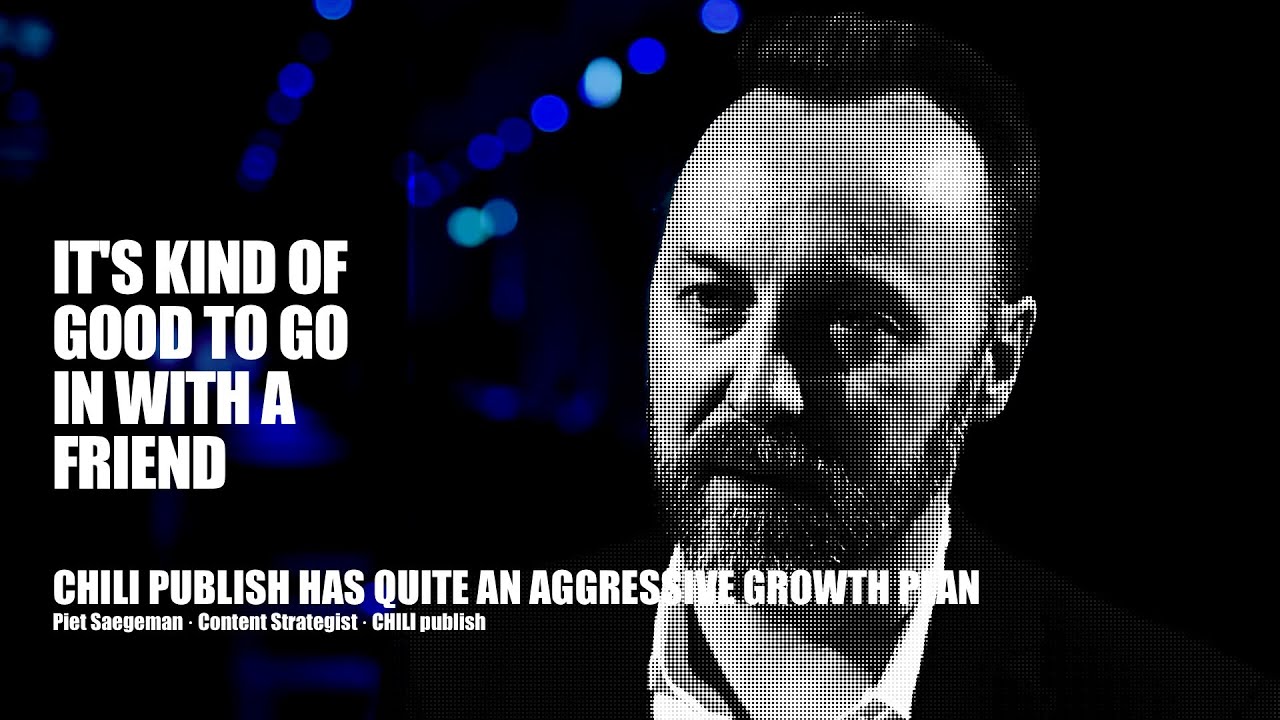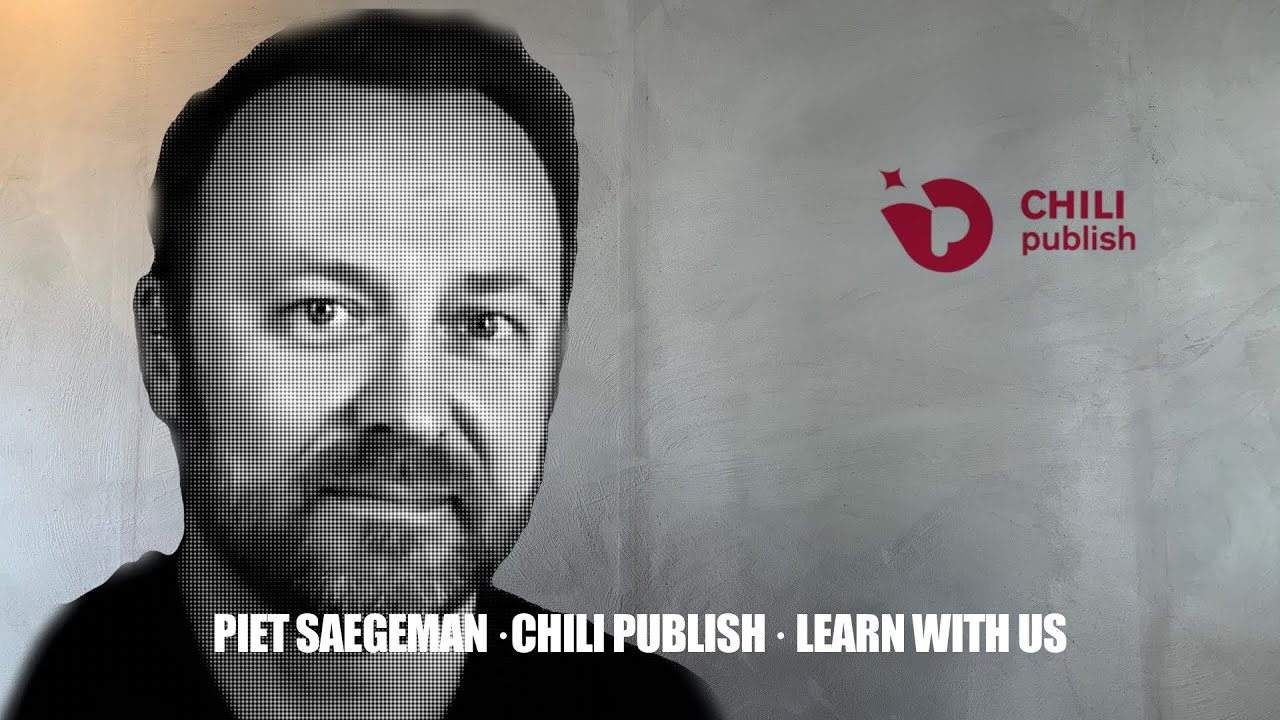CHILI has Quite an Aggressive Growth Plan · Piet Saegeman · Content Strategist · CHILI publish
One of our absolute favourites in the industry is Piet Saegeman from CHILI publish. He controls words like no other and can even use the words as a playground for kids. He is always serious when talking to him, of course, but he also knows the power of the word. In his presentation at SPICYtalks 19 in Berlin, he spoke about how the porn-industry has been a test field for many of the technologies used today. He continues with his second slide, spelling porn wrongly (pron) and jokes about that his colleagues at CHILI publish didn’t even proofread his slides.
There is no need to proofread his slides – Piet Saegeman has an enormous knowledge, and he knows exactly how to sell CHILI – so that is exactly what he does.
I LOVE this film. Enjoy!
So I’m the content strategist. That means I think of stories to tell about the product, that show how valuable it is for customers in ways that are maybe not immediately geared towards sales, more towards inspiration, more towards education on what we can do.
So when a customer makes his first steps with CHILI Publisher, we are often there to think about what they want to do. So the use cases are very different sometimes, and we look at, “Okay, how can we use the products optimally to help this customer start?” We’ll roll that into the initial training. We’ll actually roll that into the sales process, when we do the initial proof of concepts for them. And it’s really interesting for us as well, because we get to look very deeply into their process and their problem that they’re trying to solve, and we learned about how we can leverage the product to fix their issues. So it’s a very interesting period, when you’re talking from that first moment where you see a demo, and the customer goes like, “Impressive technology,” because it’s highly technical, to what is now the absolute use case, that is a working prototype of what we want to do, and then how do we scale that. So then we get the customer success team involved once the sale is handed off there, and they help the customer get the maximum use out of their product.
The way we approach the market is kind of a hybrid form, right? So we do direct sales, but we also have an extensive partner network. And a lot of our interesting projects have gone through partners, because they’re already in-house with these brands that we’re trying to reach. We often do things together, because they have their expertise. And this could be like information management, or media management, or DAM. That’s not our forte. We do one thing, and one thing only, and that is the editor, right? So we like to partner up with them, often just to go to the market to get the validation from an existing relationship, but also to tackle problems that we couldn’t tackle alone. And these can be technical, but these can also be a little more business and political, for us to get a foot in the door with certain big brands. We’re a small company out of Belgium with an aggressive growth track behind us, but we’re still a company out of Belgium, right? So if you go to the top world brands, it’s good to go in with a friend.
So the initial round has been, I think, two and a half years now. And our initial investors were so happy with the results so far, that they actually came back with more investment. So we didn’t go to a new round, it’s actually more like an extension of the first round.
Yes. So we have quite an aggressive growth plan, and so far we’ve actually … we’re tracking beautifully on our targets, that we of course discuss with the board. It’s a bit of a chicken and egg situation in the sense that you need the capital to grow, and you need to grow to get the capital, right? What we’re doing now, is we’re getting the organization ready for scale. It’s working beautifully, our development team is getting things done that we couldn’t dream of a couple of years ago. Our sales team is getting more exposure, so we’re getting … our footprint is getting bigger. We’re really happy that we have the capital to do that at this point and that, not only that, in the years that we’ve now been running on this capital, we’ve actually got all the milestones. And there’s a number of things happening that I can’t speak about, but you’ll see some interesting announcements very, very soon.
We really believe in close relationships with partners. They’ve helped us in the past, we’ve helped them in the past. So we know that this is a relationship that has a lot of potential for developing the market, that more so than if we would do it ourselves. So these partners came in, and they said, “Listen, we’d like to be a part of SPICY Talks.” They’d been here before in previous editions as participants. So during the initial discussions, they went like, “It’d be great if we could be more of a formal part of this.” And we went, “Huh, now there’s an idea,” right?
I don’t really know why there’s no printers. There’s a number of companies here as partner, that are active in the print industry, that’s for sure. But so what we do notice is as we grow as a company, and as the project evolves, our market’s changing a little bit, in the sense that yes, we do a lot more stuff that’s good for digital now, but that opens up a lot of doors for printers as well. I call it print plus. You can have a printer that has been a fulfillment partner for getting ink on paper, that can now become a fulfillment partner for putting pixels on screens. If you have that kind of relationship as a printer, you’ve got a lot more leverage with your customers, and there’s a lot more growth potential with your customers. So we’re seeing that happening in the print. The print is extending its footprint, instead of just living off the margins from getting the printed material done. And in the other system, we’ve seen … in the other scenario, we’ve seen the Bpost present, where they take the digital communication journey of the customer, and they start plugging in print with the same ease as sending an email. So it goes both ways. And I think both worlds are going to meet up more and more, and there’s going to be more overlap between print and digital.
So yes, we have … in this edition, there are companies that are very, very big. We have Colruyt, that has … essentially their inside agency is the biggest agency in Belgium, right? So that’s one end of the scale. But a brand like Airbus, and the team that builds their entire solution, is really small. There’s like a couple people in a room somewhere, that have built this fantastic solution. So we’re still covering the entire range of very small, very creative companies, one-, two-person companies, plus a couple of partners, all the way to the biggest enterprise level customers in the world.
It’s standard-hosted architecture. The install script takes minutes to do, the updates scripts take minutes to do. The management of the system itself is really bog standard. If you’ve got a virtual machine somewhere, we’re good to go.
I’m not going to admit to that, but you may have a point. And that’s a challenge. Don’t forget, the marketing teams of people in the market that we’re in, are often huge, they’re multiple times what we are. So we’ve got a digital marketer, we’ve got a programmer, we’ve got an events manager, we’ve got myself doing content, and [Cindy 00:06:54] who is the the CMO. And then [Maya 00:06:56], who’s the voice of the company, really, if you know her. For a team that small, to have this impact, I think it’s really quite spectacular. One customer I talked to yesterday compared our events to an event from a major DAM vendor recently, and he said, “Well, who’s your agency? How many people have done this?” I’m like, “Well, no. It was us.” It was one guy, [Robos 00:07:21], our events manager, who’s driving the bus on this, and everybody just helped as much as they could. So to do this without an agency, is quite spectacular. And actually if you look at the reach, and the numbers of traffic that we generate in the content usage, and the content views that we get, for a small team this size, to do this in three languages, is really quite spectacular.
Just to give you an example, there’s a startup in Ghent that runs pretty much just over our revenue, it’s a different market. But their content team is 16 people, right? So just to give you an idea.










































































